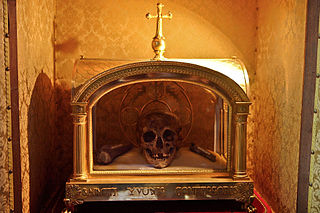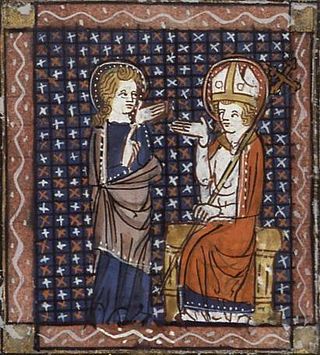
Saint Nicholas of Myra, also known as Nicholas of Bari, was an early Christian bishop of Greek descent from the maritime city of Patara in Anatolia during the time of the Roman Empire. Because of the many miracles attributed to his intercession, he is also known as Nicholas the Wonderworker. Saint Nicholas is the patron saint of sailors, merchants, archers, repentant thieves, children, brewers, pawnbrokers, toymakers, unmarried people, and students in various cities and countries around Europe. His reputation evolved among the pious, as was common for early Christian saints, and his legendary habit of secret gift-giving gave rise to the folklore of Santa Claus through Sinterklaas.

Saint Valentine was a 3rd-century Roman saint, commemorated in Western Christianity on February 14 and in Eastern Orthodoxy on July 6. From the High Middle Ages, his feast day has been associated with a tradition of courtly love. He is also a patron saint of Terni, epilepsy and beekeepers. Saint Valentine was a clergyman – either a priest or a bishop – in the Roman Empire who ministered to persecuted Christians. He was martyred and his body buried on the Via Flaminia on February 14, which has been observed as the Feast of Saint Valentine since at least the eighth century.

In religion, a relic is an object or article of religious significance from the past. It usually consists of the physical remains or personal effects of a saint or other person preserved for the purpose of veneration as a tangible memorial. Relics are an important aspect of some forms of Buddhism, Christianity, Islam, shamanism, and many other religions. Relic derives from the Latin reliquiae, meaning "remains", and a form of the Latin verb relinquere, to "leave behind, or abandon". A reliquary is a shrine that houses one or more religious relics.

Blaise of Sebaste was a physician and bishop of Sebastea in historical Lesser Armenia who is venerated as a Christian saint and martyr. He is counted as one of the Fourteen Holy Helpers.

Dymphna is a Christian saint honoured in Catholic and Eastern Orthodox traditions. According to tradition, she lived in the 7th century and was martyred by her father.

Ursula was a Romano-British virgin and martyr possibly of royal origin. She is venerated as a saint in the Roman Catholic Church, Eastern Orthodox Church and the Anglican Communion. Her feast day in the pre-1970 General Roman Calendar and in some regional calendars of the ordinary form of the Roman Rite is 21 October.

Bruno of Cologne, OCart, venerated as Saint Bruno, was the founder of the Carthusians. He personally founded the order's first two communities. He was a celebrated teacher at Reims and a close advisor of his former pupil, Pope Urban II. His feast day is 6 October.

Richard of Chichester, also known as Richard de Wych, is a saint who was Bishop of Chichester.

Severinus of Noricum is a saint, known as the "Apostle to Noricum". It has been speculated that he was born in either Southern Italy or in the Roman province of Africa. Severinus himself refused to discuss his personal history before his appearance along the Danube in Noricum, after the death of Attila in 453. However, he did mention experiences with eastern desert monasticism, and his vita draws connections between Severinus and Saint Anthony of Lerins.

A reliquary is a container for relics. A portable reliquary may be called a fereter, and a chapel in which it is housed a feretory or feretery.

Brice of Tours was a 5th-century Frankish bishop, the fourth Bishop of Tours, succeeding Martin of Tours in 397.

Saint Pantaleon, counted in Western Christianity as among the Fourteen Holy Helpers of the Late Middle Ages, and in Eastern Christianity as one of the Holy Unmercenary Healers, was a martyr of Nicomedia in Bithynia during the Diocletianic Persecution of 305 AD.

Saint Eskil was an Anglo-Saxon monk particularly venerated during the end of the 11th century in the province of Södermanland, Sweden. He was the founder of the first diocese of the lands surrounding Lake Mälaren, today the Diocese of Strängnäs. He is the patron saint of Södermanland and the Diocese of Strängnäs.

Magnus of Füssen, otherwise Magnoald or Mang, was a missionary saint in southern Germany, also known as the Apostle of the Allgäu. He is believed to have been a contemporary either of Gall or of Boniface and is venerated as the founder of St. Mang's Abbey, Füssen.
Saint Vitonus, also called Vanne or Vaune, became a monk as a young man and was later made Bishop of Verdun by King Clovis I.

October 22 - Eastern Orthodox liturgical calendar - October 24

The Basilica of St. Cunibert also St. Kunibert is the last of Cologne's twelve Romanesque churches to be built. It was consecrated in 1247, one year before work on the Gothic Cologne Cathedral began. It was declared a minor basilica in 1998 by the then Pope John Paul II.
St. Olav’s Shrine was the resting place of the earthly remains of St. Olav, Norway’s patron saint, behind the high altar of Nidaros Cathedral in Trondheim, Norway, from the mid 11th century. For nearly five centuries the shrine was of major religious importance to Norway and the other Nordic countries, and also to other parts of Northern Europe. St. Olav’s Shrine opens and closes the Middle Ages as a historic period in Norway. The shrine consisted of three shrines, the one covering the other, and was the most important and by far the most valuable object in Norway in the Middle Ages. After the Lutheran reformation in 1536–1537, the valuable parts of St. Olav’s Shrine were destroyed by Danish authorities. Since 1568 St. Olav’s earthly remains have been resting in an unknown grave, in Nidaros Cathedral or in the cathedral cemetery.

Severinus was an early bishop of Bordeaux later venerated as the patron saint of the city on account of the miracles he reputedly worked in defence of the city. He was remembered for his strong stance against Arianism. His feast day is October 21 in the latest Roman Martyrology.

The Basilica of Saint Severinus is a church built in Bordeaux at the dawn of the 11th century.


















